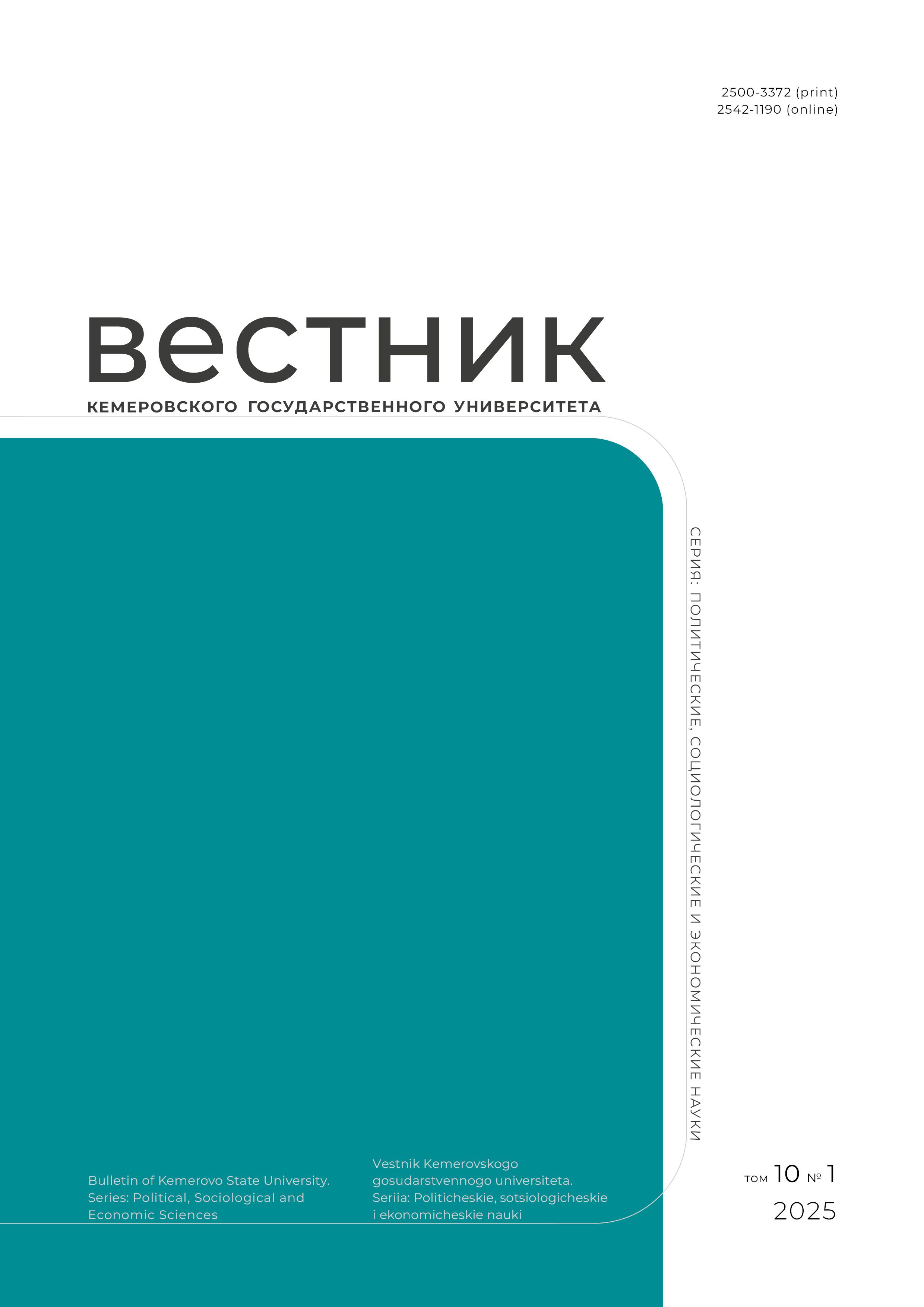Kemerovo, Russian Federation
The purpose of the article is to consider a synergetic approach to the formation of an economic space using the example of the Kemerovo Region – Kuzbass. Two agglomerations have been formed in the region, which have their own specialization with centers in the cities of Kemerovo and Novokuznetsk. The authors have revealed that Kuzbass is characterized by demographic compression, manifested in the outflow of population, and communicative compression, the positive effect of which makes it possible to strengthen the transport connectivity of space. An assessment of the transport connectivity of the space is given. The compactness of the territory and the availability of transport communications make it possible to connect municipalities with the centers of agglomerations. Agglomeration economics as a part of spatial economics studies agglomeration (synergetic) effects. To assess the agglomeration effect, labor productivity calculations were carried out in the context of the North Kuzbass and South Kuzbass agglomerations. The author used statistical data from the Territorial Body of the Federal State Statistics Service for the Kemerovo Region – Kuzbass for all municipalities, data from the websites of municipalities, statistics from the Ministry of Economic Development of Kuzbass and transport organizations. The legislative acts of the Kemerovo Region – Kuzbass and the Ministry of Economic Development of the Russian Federation formed the regulatory framework. It has been established that agglomeration effects are more related not to scale, but to the specialization of agglomerations; labor productivity is not always higher in the centers of agglomerations, since its have developed innovative activities (financial, scientific, educational, cultural and educational), which are sources of synergetic effect. It has been revealed that the manifestation of the synergetic approach in the formation of an economic environment space consists in the formation of new growth points in a resource-rich single-industry region that are not related to the leading industry: priority of development territories in four cities (Novokuznetsk, Prokopyevsk, Anzhero-Sudzhensk, Yurga), the Kuzbass special economic zone and the Sheregesh sports and tourism complex.
synergetic approach, agglomeration, economic space, agglomeration economy, growth points, Kemerovo Region – Kuzbass
1. Klepach A. N. Organization of the Russian space in the new reality. Russia’s economic policy in the intersectoral and spatial dimension: Proc. VI All-Russian Sci.-Prac. Conf., Tomsk, 21–22 Mar 2024. Novosibirsk: IEIE SB RAS, 2024, vol. 6, 79–85. (In Russ.) https://elibrary.ru/ojfpui
2. Krugman P. R., Venabies A. J. The seamless word: A spatial model of international specialization and trade. NBER, 1995. URL: https://ssrn.com/abstract=225284 (accessed 28 Mar 2025).
3. Harris C. D. The market as a factor in the localization of production. Annals of the Association of American Geographers, 1954, 44(4): 315–348.
4. Ellison G., Glaeser E. L. Geographic concentration in U.S. manufacturing industries: A dartboard approach. Journal of Political Economy, 1997, 105(5): 889–927. https://doi.org/10.1086/262098
5. Romer P. Increasing returns and new developments in the theory of growth. NBER, 1989. URL: https://ssrn.com/abstract=227464 (accessed 28 Mar 2025).
6. Holmes T. J., Stevens J. J. Geographic concentration and establishment scale. Review of Economics and Statistics, 2002, 84(4): 682–690. https://doi.org/10.1162/003465302760556495
7. Competitiveness of Russian regions in a globalized economy, ed. Rastvortseva S. N. Moscow: Ekon-inform, 2013, 335. (In Russ.) https://elibrary.ru/rwoeox
8. Spatial development of contemporary Russia: Trends, factors, mechanisms, institutions, ed. Kolomak E. A. Novosibirsk: IEIE SB RAS, 2020, 500. (In Russ.) https://elibrary.ru/lwzwlv
9. Kolomak E. A. Spatial development of Russia in XXI century. Prostranstvennaya Ekonomika, 2019, 15(4): 85–106. (In Russ.) https://doi.org/10.14530/se.2019.4.085-106
10. Kolomak E. A. Spatial development of Russia in XXI century. Region: Ekonomika i sotsiologiia, 2024, (1): 150–176. (In Russ.) https://doi.org/10.15372/REG20240104
11. Kolomak E. A. Assessment of the influence of agglomeration factors on the economic activity of the Angara-Yenisei Region. J. Sib. Fed. Univ. Humanit. soc. sci., 2023, 16(9): 1560–1566. (In Russ.) https://elibrary.ru/gordcz
12. Rastvortseva S. N., Snitko L. T. Regional specialization and agglomeration effects in the Russian economy. Economic and Social Changes: Facts, Trends, Forecast, 2020, 13(3): 46–58. (In Russ.) https://doi.org/10.15838/esc.2020.3.69.4
13. Lavrinenko P. A., Mikhailova T. N., Romashina A. A., Chistyakov P. A. Agglomeration effect as a tool of regional development. Problemy prognozirovaniia, 2019, (3): 50–59. (In Russ.) https://elibrary.ru/sfxhgx
14. Gladkey A. V. The essence of agglomeration’s effect and their influence on economic efficiency of enterprises’ regional development. Regionalnye issledovaniia, 2014, (2): 10–16. (In Russ.) https://elibrary.ru/silexz
15. Fedolyak V. S. Agglomeration and disagglomeration effects in socio-economic development of territories. Meždunarodnyj naučno-issledovatel'skij žurnal, 2024, (3). (In Russ.) https://doi.org/10.23670/IRJ.2024.141.13
16. Olifir D. I. Synergy space as the source of innovation system of urban agglomerations management and development (on the example of Sankt-Petersburg agglomeration). Russian Journal of Innovation Economics, 2019, 9(4): 1403–1414. (In Russ.) https://doi.org/10.18334/vinec.9.4.41300
17. Olifir D. I. Improving the practice of territorial planning in the St. Petersburg agglomeration: Strategic guidelines and innovative structure. Kreativnaya ekonomika, 2020, 14(10): 2331–2352. (In Russ.) https://doi.org/10.18334/ce.14.10.110939
18. Kurnosov A. V. "Controlled compression" of economic space as a strategy of adaptation to the existing reality. Ekonomika ustoichivogo razvitiia, 2023, (4): 138–142. (In Russ.) https://elibrary.ru/rwukne
19. Kurnosov A. V., Mekush G. E. Transport and communication connectivity of economic space and agglomeration as factors of economic development in the single-industry town of Belovo. Development of the Kuzbass productive forces: History, modern experience, future strategy: Proc. Intern. Sci.-Prac. Conf., Kuzbass, 17–23 Nov 2023. Moscow: RAS, 2024, vol. 3, 385–394. (In Russ.) https://elibrary.ru/dpudrm
20. Lebedeva N. A. Estimation of transport security in the north-western federal district. Scientific journal NRU ITMO. Series "Economics and Environmental Management", 2021, (2): 47–54. (In Russ.) https://doi.org/10.17586/2310-1172-2021-14-2-47-54
21. Chuvashova M. N., Mylnikova A. A., Gorbacheva A. K. The study of issues of regional space connectivity with using of information and communication technologies. Fundamental research, 2020, (12): 240–245. (In Russ.) https://doi.org/10.17513/fr.42940
22. Sinitskaya N. P., Aleshina G. N. Transport and communication permeability of interregional borders as a factor of spatial connectivity of the territory. Gradostroitelstvo, 2019, (5): 9–13. (In Russ.) https://elibrary.ru/ocnntk
23. Trubekhina I. E. factors of spatial differences in labor productivity in manufacturing at the municipal level (the Siberian Federal district case study). Regional economics: Theory and practice, 2015, (11): 49–62. (In Russ.) https://elibrary.ru/tljman
24. Mekush G. E., Panov A. A., Kurnosov A. V. Structural changes and cluster formation as the basis of the competitiveness of the region’s economy. Regional economics: Theory and practice, 2024, 22(12): 2213–2233. (In Russ.) https://doi.org/10.24891/re.22.12.2213

















